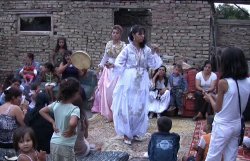FISH ON!
Estonia/Norway/USA, 2008, 60 min
Liivo Niglas, Diane Perlov, Frode Storaas
30.01.2010 14:05
 The Klamath River of Oregon and California is one of the most important salmon runs in the United States. While diminished over the past 100 years, it still supports an abudance of life and diverse economies struggling over its future course. This is a film about the Indian tribes of the river ecosystem – what the Klamath means to them and how they draw on traditional and modern resources to restore its strenght, beauty and balance. The film focuses on the Klamath River and the Indian tribes of the lower basin – the Yurok, Hoopa and Karuk. Yet this story has implications for any number of river ecosystems and indigenous peoples around the world. Through the Indian tribes of the Lower Klamath, the film reminds us how the health of a people and the health of its lands are integrally linked.
The Klamath River of Oregon and California is one of the most important salmon runs in the United States. While diminished over the past 100 years, it still supports an abudance of life and diverse economies struggling over its future course. This is a film about the Indian tribes of the river ecosystem – what the Klamath means to them and how they draw on traditional and modern resources to restore its strenght, beauty and balance. The film focuses on the Klamath River and the Indian tribes of the lower basin – the Yurok, Hoopa and Karuk. Yet this story has implications for any number of river ecosystems and indigenous peoples around the world. Through the Indian tribes of the Lower Klamath, the film reminds us how the health of a people and the health of its lands are integrally linked.
Awards: Diploma, Matsalu International nature Film Festival, Estonsko 2009; Finalist, Kyoto University Museum Academic Film Competition, Japonsko 2009
Language of dialogues: English


 In October 2007, a group of artists of different nationalities set up atablao flamenco in front of Seville’s Cathedral. They claimed this public space as a place to exhibit and express their art. The audience’s applause transformed these artists into the flamenco group “Son de Afuera” (Not from here). This short documentary shows what it means to feel and create flamenco from “outside” in the context of Andalusian society.
In October 2007, a group of artists of different nationalities set up atablao flamenco in front of Seville’s Cathedral. They claimed this public space as a place to exhibit and express their art. The audience’s applause transformed these artists into the flamenco group “Son de Afuera” (Not from here). This short documentary shows what it means to feel and create flamenco from “outside” in the context of Andalusian society.